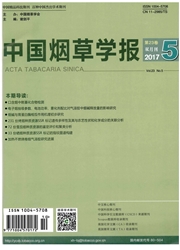

 中文摘要:
中文摘要:
为揭示品种间烟叶品质的差异和筛选耐氮肥品种,研究了烤烟品种在不同氮素营养条件下氮代谢的差异。结果表明:氮低效与氮高效品种相比,可溶性蛋白和总氮降解量大,谷氨酰胺合成酶(GS)活性低,降幅大,谷氨酸脱氢酶(GDH)活性高,硝酸还原酶(NR)活性低,氨气补偿点高,品种间差异显著。随着施氮量的增加,氮低效品种氮素营养物质降解量百分数高,GS活性降幅大且受施氮量影响较小,GDH活性和氨气挥发潜力增大,与氮高效品种相比差异显著。NC89和豫烟10号分别在施氮量在45.00和60.00 kg·hm-2时氮代谢生理强度最大,而且豫烟10号各处理间差异小于NC89。说明不同氮效率品种烟叶的氮素再同化和转移能力存在差异,氮低效品种对氮素再同化量小,再转移量大,对氮素的应用范围广,调节能力强,而氮高效品种再同化量大,转移量小,对氮素的应用范围小,调节能力弱。烟叶衰老期氮代谢与烟叶衰老速度有关,其中GS对NH4+的再同化能力和质外体对NH4+的转移能力起主导作用。
 英文摘要:
英文摘要:
Differences of nitrogen (N) metabolism under different nitrogen nutrition were investigated to select nitrogen-resistant tobacco varieties. Results showed that, compared with N efficient variety, N inefficient variety had large amount of soluble protein and total N degradation, low glutamine synthetase (GS) and nitrate reductase (NR) activity, high glutamate dehydrogenase (GDH) activity and ammonia compensation point. With the increase of N application, N inefficient variety displayed high percentage of nitrogen nutrient degradation, big decrease of GS activity, and increased GDH activity and ammonia volatilization potential. NC89 and Yuyan10 reached the largest N metabolism physical strength at the N application rate of 45.00 and 60.00 kg·hm-2 and Yuyan10 showed less changes under different treatments as against NC89. It was concluded that varieties of different N efficiency on N assimilation and transfer ability were different for N inefficient and N efficient varieties, with the former boasting large re-assimilation rate, small amount of retransfer, wide scope of N application and strong adjustment ability. N metabolism was associated with tobacco leaf aging speed with GS for NH4+ assimilation and apoplast for NH4+ transfer playing the leading role.
 同期刊论文项目
同期刊论文项目
 同项目期刊论文
同项目期刊论文
 期刊信息
期刊信息
